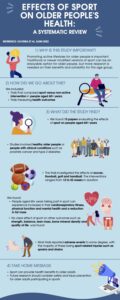In this blog we will describe the findings of our recent review of the effects of sport for people aged 60 years and older.
Why is this study important?
The number of older people is increasing rapidly around the world. It is expected that there will be more than 2 billion people over the age of 60 years by the year 2050, and will outnumber adolescents and young people for the first time in history. This means that having suitable opportunities to support older people’s mental and physical health is becoming increasingly important. The four domains of physical activity are work, active transport, household and leisure. Sport is a type of leisure-time physical activity that could be an enjoyable option for older people to be active. Previous reviews have shown the benefits of remaining physically active into older age, but have focused on activities like resistance training, general aerobic exercise and balance training. There has been very little focus on the benefits and risks of sport for older people..
How did the study go about this?
We reviewed the randomised controlled trials that have been published on the effects of sport in people aged 60 years and older. To make sure our results were not influenced by other interventions, we only included trials where sport was compared to a non-active control group, and we excluded any trials where the people receiving the sport intervention also received another non-exercise intervention (like nutrition advice) unless this was also received by the non-active control group. Included studies measured relevant health-related outcomes, such as physical activity, social functioning (participation), physical functioning, cognitive and emotional functioning, well-being or quality of life.
What did the study find?
We found that there were only 15 papers, from 9 trials evaluating the effects of sport on people aged 60 years and older. These trials had all been undertaken in high or upper-middle income countries and included healthy people (without any known disease) or people with specific clinical conditions (prostate cancer and type 2 diabetes ). The included sport interventions were soccer, floorball (similar to hockey), golf and handball, with interventions ranging from 12 to 52 weeks in duration.
Combining the results of these trials, we found that there is some evidence that people aged 60 years and older taking part in sport can experience increases in their cardiorespiratory fitness, physical function and mental health and a reduction in fat mass. Several studies also measured strength, balance, lean mass, bone mineral density and quality of life, but there was no clear effect of sport on these outcomes.
Most trials reported adverse events to some degree, with the majority of these being sport-related injuries such as sprains and strains. There was only one serious adverse event related to the intervention reported, with a shin scratch becoming infected and requiring further treatment.
What are the key take-home points?
Our findings show that sport can provide another option (beyond traditional exercise training) for gaining health benefits from physical activity in people aged 60 years or older. More research is needed to further understand the health effects of participation in different types and amounts of sports for this age group. The risk of injuries from sport participation does need to be considered, and so future research should also look at how to maximise safe participation for this population.

Authors and affiliations
Juliana S Oliveira (1,2), Stephen Gilbert (1,2), Marina B Pinheiro (1,2), Anne Tiedemann (1,2), Liane B Macedo (3), Laísa B Maia (4), Wing S Kwok (1,2), Leanne Hassett (1,5), Catherine Sherrington (1,2)
- Institute for Musculoskeletal Health, The University of Sydney and Sydney Local Health District, Sydney, Australia
- Sydney School of Public Health, Faculty of Medicine and Health, The University of Sydney, Sydney, Australia
- Faculty of Health Sciences of Trairi, Universidade Federal do Rio Grande do Norte, Santa Cruz, Brazil
- Department of Physiotherapy, Universidade Federal dos Vales do Jequitinhonha e Mucuri, Diamantina, Brazil
- Sydney School of Health Sciences, Faculty of Medicine and Health, The University of Sydney, Sydney, Australia